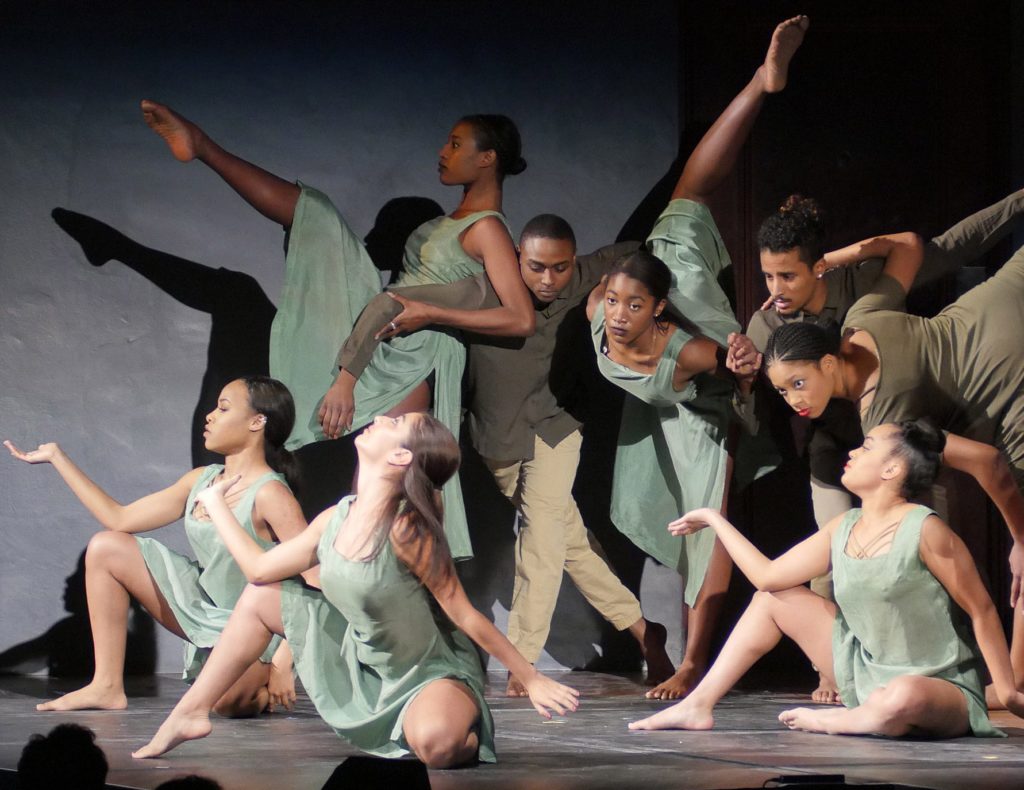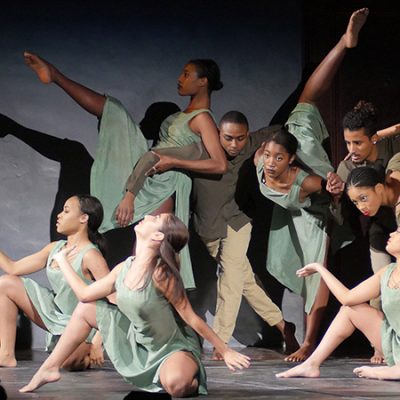By Marilou Carlin, director of communications and editor of Michigan Muse

Students performing “Through Our Eyes” at the 2018 Collage concert. Front row: Le’Elle Davis, Johanna Kepler, Sarah Morgan. Back row: Kandis Terry, Benjamin Marshall, Kiara Williams, Craig White, Mariah Stevens
A student-choreographed dance about racism at U-M opens eyes and sparks conversation.
It is protocol at SMTD’s Collage Concerts for the audience to hold their applause until the end of the performance. This practice ensures that one act morphs seamlessly into the next while maintaining the concert’s trademark element of surprise: early music followed by big band jazz followed by a scene from Shakespeare followed by a saxophone quartet, and so on.
But every once in a while, audience members can’t contain themselves, and spontaneous applause erupts.
That was the case at the 2018 Collage, at the conclusion of “Through Our Eyes,” the only dance work on the program. Featuring an African American and Latinx cast, the piece was choreographed by sophomore Johanna Kepler in collaboration with dancers Kiara Williams, Kandis Terry, Sarah Morgan, Mariah Stevens, Le’Elle Davis, Benjamin Marshall, and Craig White.
This work of art for social justice was created in response to the spate of racist incidents that have wracked the city of Ann Arbor and the U-M campus in the last two years.
The work’s sound score was an edited four-minute recording compiled from 50 interviews about racism at Michigan, which Kepler conducted with students of color from across campus. It was interspersed with lines from Maya Angelou’s “Still I Rise,” a paean to resilience in the face of racism, which was recited live on stage by voice students Zion Jackson and Jaime Sharp, along with their own vocalizations.
The recording was powerful: “Being a student of color on this campus, it feels like we have a constant target on our backs” … “I’ve never read a single novel by a Latinx author in any of my classes” … “I feel very sad, and very disadvantaged, and very disheartened as a black female on this campus” … “I was the student who had the ‘N-word’ written on his doortag—I felt overwhelmed and I felt the pressure again of, you know, I’m not welcome here.”
“There was initial hesitation about the language—the unflinching testimonials,” said Professor Amy Chavasse, who acted as a faculty advisor to Kepler and the dancers. “There was a sense that the themes inherent in ‘Through Our Eyes’ were not compatible with the spirit and history of Collage. Johanna was committed, however, to staying true to the message, idea, and purpose of her work, and to the students whose voices she was sourcing. I felt an enormous sense of gratitude and awe that she was boldly and directly taking this topic on.”
Though the student voices were dire, Angelou’s words offered hope: “You may shoot me with your words, You may cut me with your eyes, You may kill me with your hatefulness, But still, like air, I’ll rise.”
Kepler, a native of Guatemala who was adopted and raised in a primarily white and well-to-do area of Massachusetts, has had a difficult time adapting to life at U-M due to the racism that she and many students of color see as pervasive. A Latino Studies minor, she is a member of the Latinx Alliance for Community Action, Support, and Advocacy (La Casa) and was appointed by SMTD’s chief diversity and inclusion officer, Freyja Harris, as a SMTD Diversity, Equity & Inclusion (DEI) student ambassador, representing dance. With other dance students, Kepler started a departmental group, “Arts and Color,” to encourage faculty and students of all levels to come together to discuss racial injustices within the community. But the blatant stream of racially charged episodes on campus motivated her to do more.
“Every time some incident happens, it gets addressed with an email from administration, but nothing seems to change; it was getting really frustrating,” said Kepler. “So I thought, ‘Why not use my art to create a piece?’ I want people to start talking about this; I want white students who aren’t exposed to racism to hear our stories.”
That goal was achieved: Kepler said that several white students approached her and the cast after the Collage performance to say, “Wow, do you guys really feel like that? I had no idea,” which Kepler sees as a good starting point. “Through Our Eyes” has since had multiple performances at a variety of campus events, and Kepler is planning to adapt it for a screendance that can reach an expansive online audience.
Student-driven efforts like this complement U-M’s goal of creating a diverse, equitable, and inclusive campus environment. Michigan’s recommitment to DEI, under the leadership of President Mark Schlissel, has resulted in a detailed strategic plan, launched in the fall of 2016, to which 50 U-M units contributed. A Year One progress report was released last fall, with significant progress reported across the 34 campus-wide initiatives, with 85 percent of nearly 2,000 action items either completed or underway.
The focus on DEI is also reflected in the dance department, led by its chair, Jessica Fogel. “We have recognized the need to attend to issues of DEI on a daily basis,” said Fogel, “in our interactions with each other, our discussions about curriculum, our course assignments and readings, the choice of our guest artists, our ways of looking at dances, our dancemaking, our hiring, our marketing, and more.”
Fogel says the department is diversifying its technique curriculum in ways they haven’t done before, by broadening their standard ballet, modern dance, Congolese, and improvisation curriculum to now include more diverse genres. In addition, for the past three years, they have offered workshops that address some of the basic tenets of DEI. “Each of these efforts form steps towards a new awareness,” said Fogel, “and the work is ongoing.”
In many ways, said Fogel, the dance students themselves are leading the charge. “We were very proud to have ‘Through Our Eyes’ represent our department at the 2018 Collage concert,” she said. “The dancers were moving and courageous in expressing their feelings about this difficult topic. This is a performance that will long be remembered.”
Chavasse agrees. “I was so moved when I first saw the piece, recognizing that the Department of Dance was in a unique position to support a talented and dedicated undergraduate as she figured out how to confront inequality through her art-making.”
While addressing social justice issues is common in all the performing arts, it is especially prevalent in dance. “With the body as the prime instrument of expression, dance can offer a powerful commentary, raising uncomfortable questions that challenge the status quo,” said Chavasse. “Historically, choreographers have tackled controversial issues through dance in many ways, guided by the underlying belief in the art form’s unique ability to stimulate debate, draw people together, and ultimately initiate changes in outlook and perspective.”
Kepler, who received a U-M MLK Spirit Award for her leadership and advocacy with SMTD students as a DEI ambassador, is now a believer in dance as an instrument of change as well.
“I think art touches people in ways that facts don’t,” she said. “Dance brings people to the theatre, and dance brings people together. So it’s just about figuring out a way to touch people and motivate them into action.”


